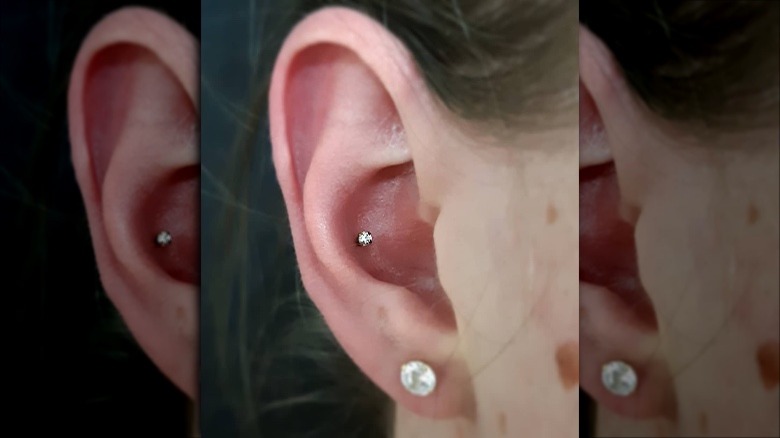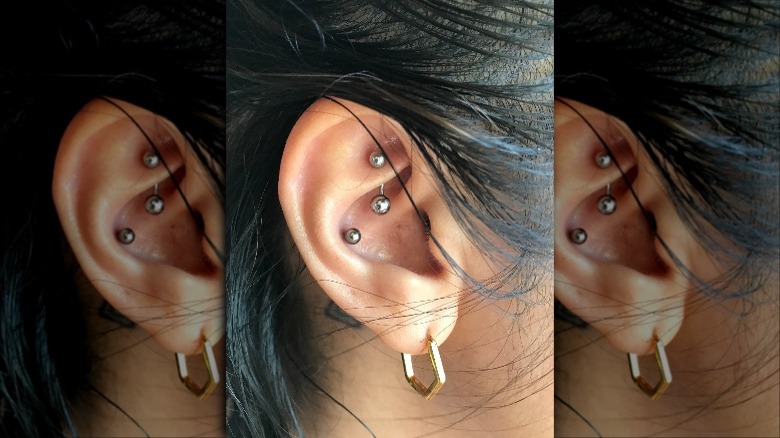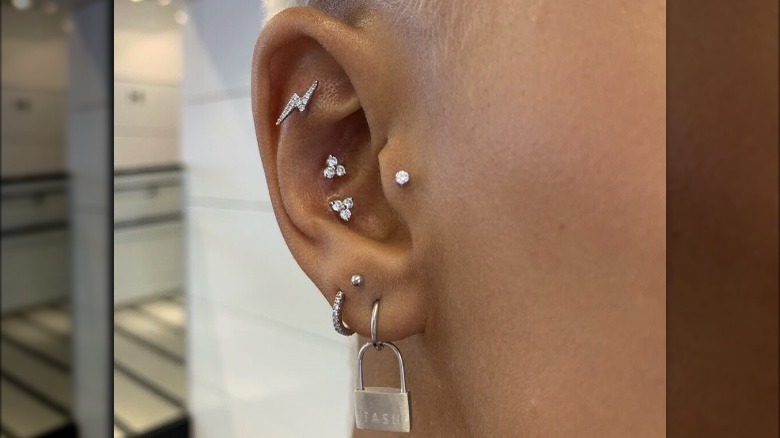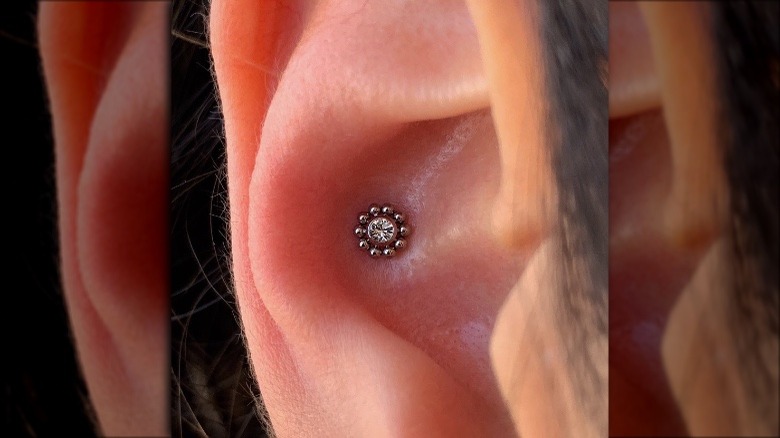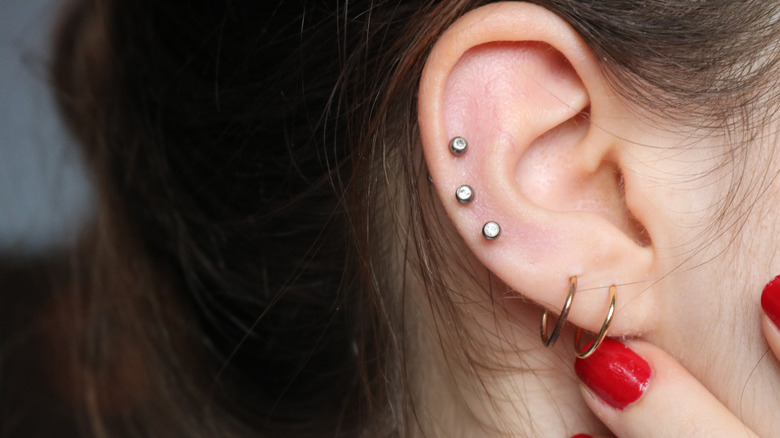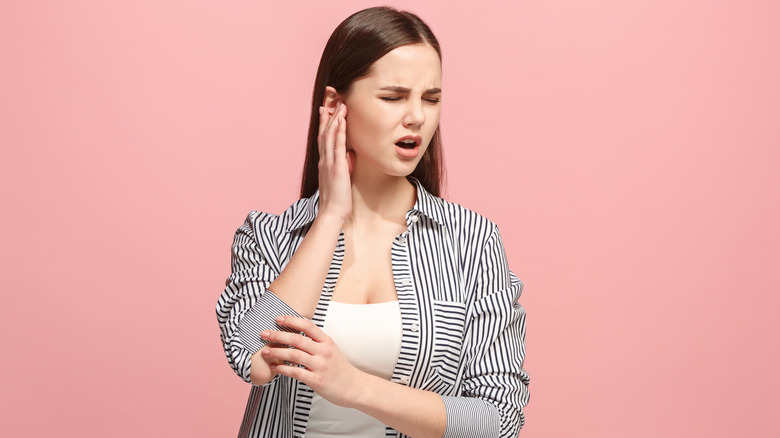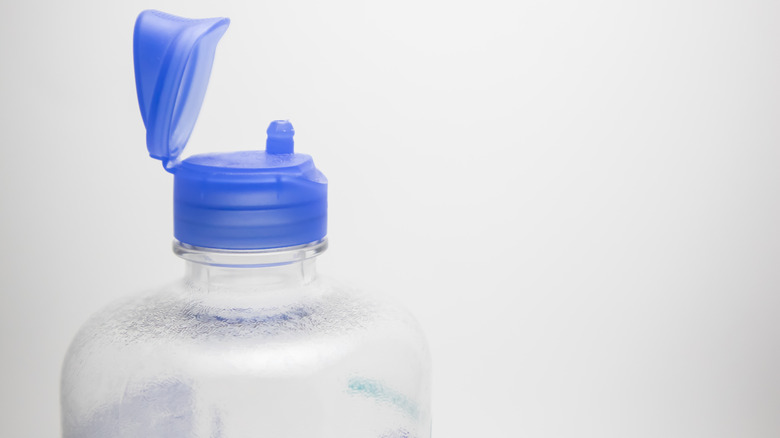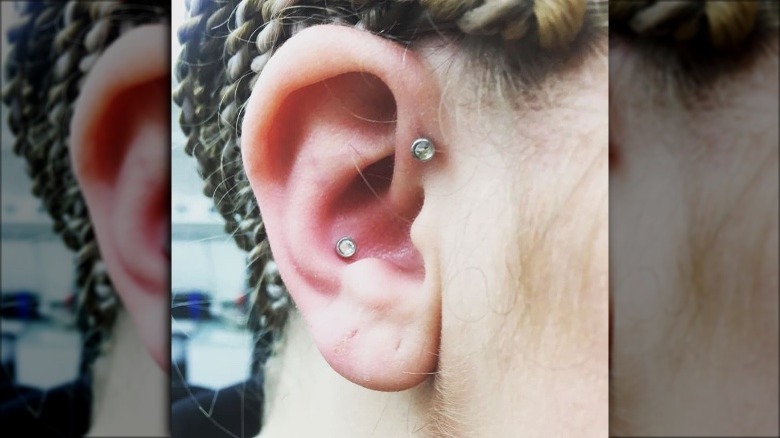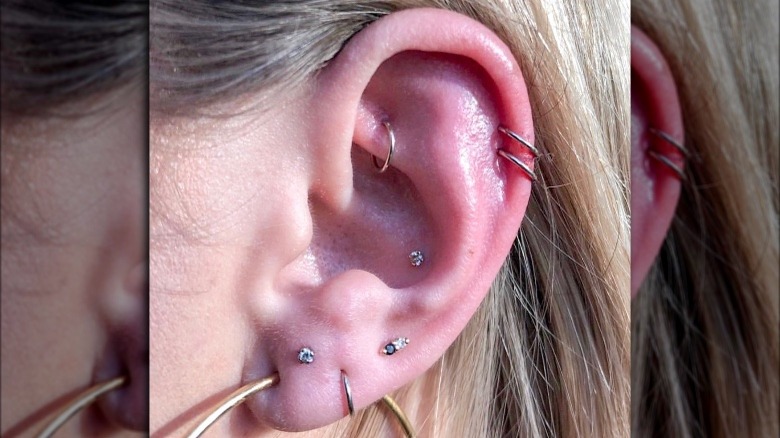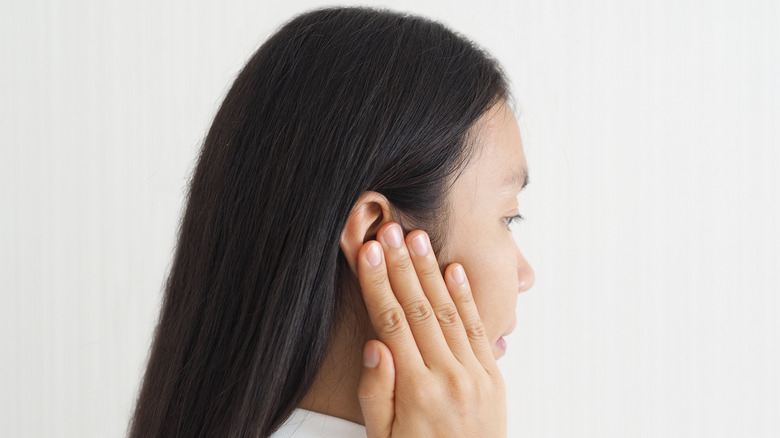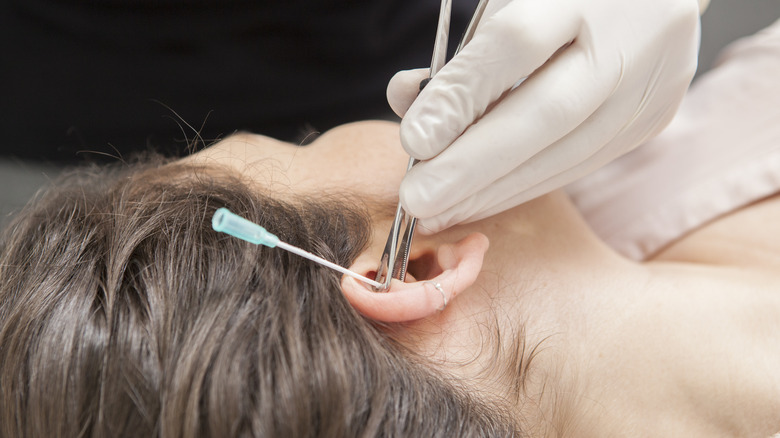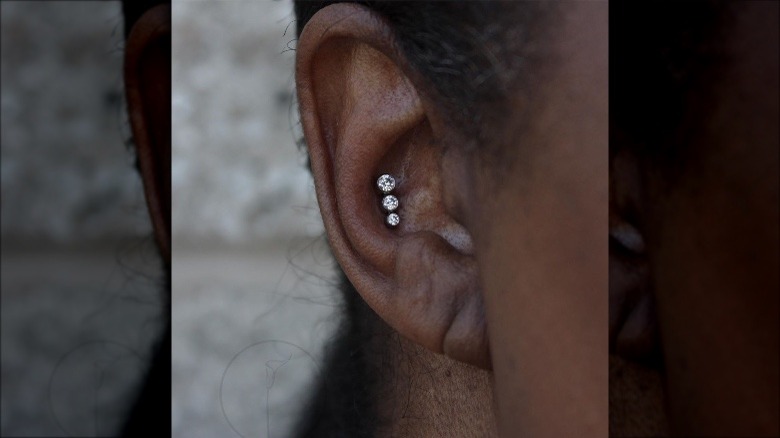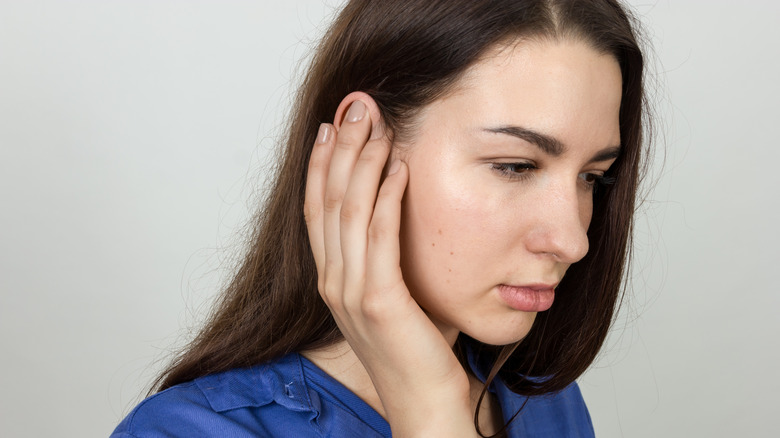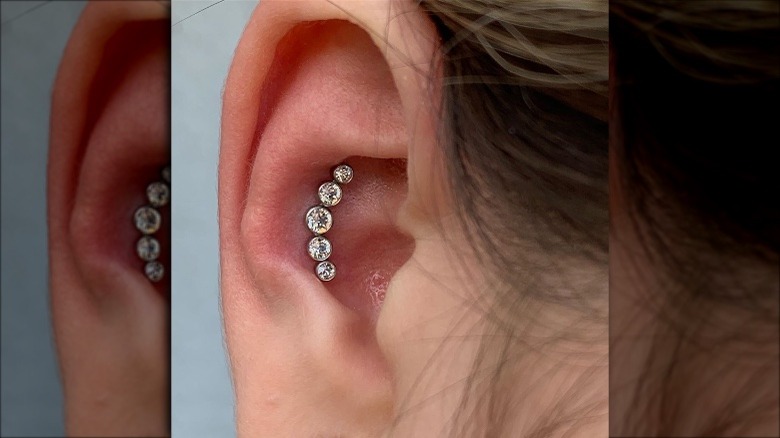The Truth About Conch Piercings
Fancy a conch piercing? Well, you're not alone in wanting more piercings, as, in a report published in 2017, the American Academy of Pediatrics revealed young people are getting pierced more than ever before in history. That number has likely continued to grow. "There's more every year," Dr. Jay Greenspan, chairman of pediatrics at Nemours/A.I. Dupont Hospital for Children, confirmed when speaking to USA Today.
Of course, you don't have to be a "young" person to get a piercing. In August 2019, 45-year-old Victoria Beckham showed off her brand new piercings in an Instagram Story (via Hello! magazine). "The helix, forward helix and conch piercings are new this summer," Beckham revealed.
According to Ben Tauber, a pro piercer at one of New York City's Maria Tash piercing studios, "The conch [piercing] has really taken off lately..." Even if you don't have any other ear piercings, Tauber told Refinery29 that "a conch piercing makes a statement" all by itself, adding, "You don't need other stuff to make it work." If you're considering getting this piercing, here's everything you need to know.
What even is a conch piercing?
Before you walk into a piercing studio and ask for a conch piercing, you should probably know just what you're requesting. According to Piercing Studio Wien, "A conch piercing is a perforation of the auricle" — or the external area of the ear.
The auricle is a relatively large area, so conch piercings aren't relegated to just one spot. In fact, piercers recognize two types of conch piercings: the inner conch (pictured above), which is located near the center of the ear, and the less popular outer conch. "The outer conch is above the depression and could also be defined as a lower helix piercing," the studio explained. "Most customers confuse a helix piercing with a conch/outer conch piercing."
To make matters even more confusing, some consider the outer conch not be the area just under the fold at the top of the ear, but to be low in the depression (via Byrdie). As such, it's important to know which piercing you actually want so you don't end up with a totally different look. By all means, point if you have to.
Who should get a conch piercing?
If you don't think you can pull off a conch piercing, rest assured: you definitely can. "A conch piercing is suitable for many ears and suits all styles," Rhianna Jones, head piercer at The Circle in London, England, explained in an interview with Byrdie. "In my many years of piercing, I have not come across one that wasn't suitable."
Conch piercings are unique in that they can be as loud or unassuming as you want them to be. "Working with the anatomy of each ear, the placement can achieve a subtle look or be a statement piece, depending on the style and desires of the client," Jones revealed. Whichever look you're desiring, you'll want to make sure you communicate that with your piercer. This is one of the many reasons it's important to pick the right piercer. Jones told the publication, "My advice to anyone interested in getting a new piercing is to research your piercer before choosing where to go..." Sage advice, to be sure.
Consider placement before getting a conch piercing
As The Circle's head piercer Rhianna Jones told Byrdie, you have some wiggle room when it comes to the placement of your conch piercing. "Since the conch [piercing] is done through the outer part, it can be done pretty much within any angle," DaVo, professional body piercer and owner of the Axiom Body Piercing Studio in Des Moines, Iowa, revealed in a YouTube video on the Body Piercing & Tattooing channel. He continued, saying, "It can be done in a way where it kind of flows with those natural ridges."
According to DaVo, it all comes down to three things: your imagination, your anatomy, and the piercer's ability. "It's one of those piercings where if the piercer is doing it correctly, it can kind of fit into that flow and naturalness of the ear and not look out of place," the piercer explained. Although we probably don't need to say it again, we will: Choose your piercer wisely! You may want to get a piercing spontaneously, but, when it comes to body modification, it pays to do your due diligence.
How to choose jewelry for your conch piercing
If you've been browsing #ConchPiercings on Instagram, you already know that there's tons of jewelry options, like bars and hoops and everything in between. However, you should know that you're likely going to be limited in what jewelry you can get at the start. Cassi Lopez, head piercer at New York Adorned, told Refinery29 that it's best to choose studs. Because studs are both thicker and larger overall, they won't move as much as hoops — and that means they'll heal much faster, she explained.
Opting for studs when getting your conch piercing may restrict some of your jewelry options, but you can still choose your metal. Whether you decide to go with silver or rose gold, Maria Tash piercer Ben Tauber advises doing "what you want to do and what feels right for you." He continued, telling Refinery29, "More times than not, people who listen to their friends come back a week or two later to do what they originally wanted."
Consider your other ear piercings before getting a conch piercing
When it comes time to pick your jewelry for your conch piercing, you may want to consider your other ear piercings. If you have several hoops in each ear and they're all gold, are you really going to want a silver studded conch? Although there really are no "rules" when it comes to mixing metals, Ben Tauber, piercer at Maria Tash in New York City, said rose and yellow golds can look off when positioned next to each other. "It tends to look like you had two of the same rings, but something is a little bit wrong with one of them," he told Refinery29.
But what if you don't have any other ear piercings? You may just want to take the opportunity to get your lobes pierced at the same time. It's certainly doable to knock out a few piercings at once. That said, there is a limit. "I try not to exceed four or five piercings at once," Tauber told the publication. "Any more and it gets tricky for the body to heal it, and I want stuff to look good and be there forever."
Where the conch piercing falls on the pain scale
We're not going to sugarcoat it and say that a conch piercing doesn't hurt, but it's not that terrible. "Any piercing is painful to a degree," Rhianna Jones, head piercer at The Circle, told Byrdie. "It varies for each person. But on the whole, it is pretty much the same as other ear parts and not that bad!"
If your experience with piercings has been confined to the earlobes, though, a conch piercing is going to feel quite different. Basically, your earlobes are comprised of soft tissue, whereas the auricle where a conch piercing is placed contains cartilage. This is why your earlobes are floppy and the rest of your ear is, well, not quite so floppy. Unfortunately, piercing cartilage versus piercing a lobe "will hurt a bit more," Brian Keith Thompson, Beyoncé's very own ear piercer, confirmed to Elle.
But try not to worry. "My advice is not to focus on the pain because it's so short-lived (piercings don't take long at all) and it's mostly mental," the expert added. "It's your brain trying to take care of your body but everyone can manage it."
Aftercare is everything when it comes to conch piercings
Even if your conch piercing ends up being relatively painless, you'll still have experienced bodily trauma. It sounds scary, but all piercings, including septum piercings, can be classified this way because, although intentional, they're still physical injuries. And, as would be the case with any other wound, your body is going to react. For most people, that means some swelling and redness around the piercing site, said Maria Tash of the eponymous Maria Tash piercing studios in New York City. "We see more redness due to harsh [cleaning] products" than from infection, she explained to HuffPost.
According to Tash, you should clean your new piercing twice a day using a very mild cleanser, like a sterile saline wound wash. This will aid the healing process along while not irritating sensitive skin. It was once advised to use antibiotic ointment on new piercings, but Tash said this has been found to do more harm than good. Unlike a saline wash that rinses and cleanses, ointment may collect dust that can later infiltrate the piercing. Eek.
It's going to take a while for your conch piercing to heal
You're going to want to keep cleaning your conch piercing with saline wash not until it stops hurting, but until it completely heals. We hate to break it to you, but this is going to take quite a bit of time. "Cartilage is not very vascular tissue and because blood flow is an integral part of the healing process the healing time takes a bit longer," Ashley, a piercer at Venus by Maria Tash, told Bustle. She confirmed, "Healing time is six months to a year." Oof.
It is possible for your piercing to heal in less time. Rhianna Jones, head piercer at The Circle in London, told Byrdie to expect an average of "three to nine months." She continued, saying, "This varies due to how well the aftercare is followed and the client's general health." In addition to cleaning your conch piercing with a saline wash twice daily, Jones said you'll want to avoid sleeping on the piercing, and, no matter how much you may want to, "don't fiddle with it!"
Be patient with your new conch piercing
Babying your conch piercing for up to an entire year is a commitment that requires a whole lot of patience. Chances are, you're going to want to experiment with different types of jewelry before your healing time is up. We get it, but you should resist that urge.
"Most people get a conch with the intention of putting a ring in," Cassi Lopez, head piercer at New York Adorned, told Refinery29. But a hoop generally isn't used during the initial piercing and while you can certainly change from a stud to a hoop later on, there's going to be a long waiting period in between. "Be sure it's fully healed first, or you will end up with bumps from irritation," Lopez revealed.
In a YouTube video, DaVo, owner of the Axiom Body Piercing Studio and professional body piercer in Des Moines, Iowa, acknowledged this as one of the cons of conch piercing. However, it's not forever. "After it heals, you have a little bit more freedom, but during the healing process it can be very restrictive," he added.
An allergic reaction is possible after getting a conch piercing
Even if you don't change jewelry prematurely, you may still encounter bumps on your ear. If this happens within the first few hours or days of getting your conch piercing, you could be having an allergic reaction — and the metal in your piercing jewelry may be to blame. "Nickel is a common allergen," board-certified dermatologist Amy J. Derick told HuffPost. According to Mayo Clinic, some signs of a nickel allergy are itching, blisters, or a rash with bumps that form on the skin.
Despite being a common allergen, nickel is still frequently used in jewelry. If you believe you could be allergic to this metal, you should opt for hypoallergenic metals like surgical-grade stainless steel, 18-karat yellow gold, and sterling silver. Even if you request hypoallergenic jewelry, you'll still want to confirm that the piercer is using "sterile, nickel-free or surgical-grade stainless steel needles in sealed packages." Mayo Clinic further advises choosing your piercing studio carefully.
Complications can happen after getting a conch piercing
Allergies are not the only thing to keep in the back of your mind when considering a conch piercing. Being aware of potential complications can help you make a well-informed decision and spot any red flags after getting pierced.
One frequently cited study from the late '90s found that complications arise in up to 35 percent of piercings. Compared to earlobe piercings, cartilage piercings are at a greater risk for infection, the Journal of the American Medical Association (via WebMD) revealed. However, the study stated that major complications are rare; just one percent of complications were reported as major, wheres the vast majority were minor infections followed by allergic reactions. These infections can arise when you're "actually getting the piercing," board-certified dermatologist Amy J. Derick told HuffPost, "or later, in a piercing that's already been done but didn't heal well."
One complication known as the Pseudomonas infection can be "cosmetically devastating," albeit "not life-threatening," epidemiologist William E. Keene told WebMD. "Untreated, the cartilage dies and needs to be surgically removed. And without cartilage to maintain the ear's shape, you get these deformities." It's imperative to make sure your piercer is using "a sterilized needle or encapsulated gun."
Your conch piercing may lead to scarring
After getting a conch piercing, some people may develop a keloid, a type of thickened scar tissue. According to Healthline, a saline wash is not only helpful for cleansing your piercing site, but also for washing away debris and dead skin cells that can form keloids around the piercing. Although keloids are completely benign, they are very difficult to remove and, even when they are surgically removed, they are likely to come back, Healthline revealed.
Anyone can develop a keloid after a piercing, but some people are at an increased risk. According to American Family Physician, black, Hispanic, and Asian populations are 15 to 20 times more likely to develop keloids. You are also considered to be at a higher risk if you are under 30 years old, pregnant, or have a family history of keloids. Still, keloids are a relatively rare complication of ear piercings. Of the 35 percent thought to experience complications, only 2.5 percent of subjects in a 1998 study reported developing a keloid.
Whatever you do, don't take your conch piercing out
If you wind up experiencing a complication from your conch piercing, your first reaction may be to take out the jewelry. If you do that, though, you'll actually risk having another complication. According to Healthline, taking out the jewelry while you're still experiencing symptoms can lead to developing an abscess. "Although you may want to, you shouldn't remove your jewelry until your symptoms subside," the article advised.
If you experience symptoms like fever, nausea, or vomiting, you should consult your piercer or a medical professional immediately. Although minor symptoms can be treated at home, it's best to deal with anything potentially serious right away.
You may also feel compelled to take out your jewelry for reasons other than complications. As DaVo, professional body piercer and owner of the Axiom Body Piercing Studio in Des Moines, Iowa, highlighted in a YouTube video, some competitive sports require all jewelry to be removed. In such situations, DaVo suggests waiting until you've finished playing that sport or have a long enough break from it to get a conch piercing. "That jewelry needs to stay in until it is completely healed," he reiterated.
How much does a conch piercing cost
Like all piercings, a conch piercing comes with some risks. Even after it's fully healed, it can give you some trouble or make you go through what Axiom Body Piercing Studio piercer DaVo dubbed "stages of grumpiness." This can happen from sleeping on the piercing or changing jewelry, or it might just occur seemingly "out of the blue," according to the piercer.
Still, there's really no denying just how rad a conch piercing is. DaVo confirmed that it's a "very unique piercing." He continued, saying, "They have gained a little bit of popularity, let's say, in the last couple years and I am doing more of them than I did ever before, but they're still a very unique and interesting piercing that not everybody's going to have."
So, just what is it going to cost you to get this cool piercing? Although it varies by location, Byrdie reported that it could be as little as $40 to $60, which may or may not include jewelry.

